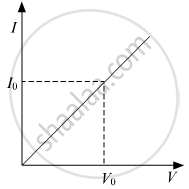Advertisements
Advertisements
Question
Answer the following question.
While studying the dependence of potential difference ( V) across a resistor on the current (I) passing through it, in order to determine the resistance of the resistor, a student took 5 readings for different values of current and plotted a graph between V and t. He got a straight line graph passing through the origin. What does the straight-line signify? Write the method of determining the resistance of the resister using this graph.
Solution

The straight-line graph between the potential difference ( V) and current(I) shows that resistor is a linear element and follows Ohm's Law.
Calculation of Resistance: At any point on the graph, resistance is given as,
`"R" = ("V"_° ("value of potential difference at that point"))/("I"_° ("value of current at that point"))`
In other words, the Slope of the graph at any point gives the value `1/"R"`
Hence,
slope `="I"_°/"V"_° = 1/"R"`
`⇒ "R" = 1/"slope" =( "V"_° ("Value of Potential difference at that point"))/("I"_° ("Value of current at that point"))`
APPEARS IN
RELATED QUESTIONS
State how are the two resistors joined with a battery when same current flows in each resistor.
Define the term resistivity and state its S.I. unit. Which will have higher resistivity a conductor or an insulator.
State expression for Resistance connected in parallel.
Write an expression for calculating electrical power in terms of current and resistance.
Six equal resistors of 1 ohm each are connected to form the sides of a hexagon ABCDEF. Calculate the resistance offered by the combination if the current enters at A and leaves it at D.
A metal wire of resistance 6 Ω is stretched so that its length is increased to twice its original length. Calculate its new resistance.
With the help of a circuit diagram derive the formula for the resultant resistance of three resistances connected:
- in series and
- in parallel
If the current I through a resistor is increased by 100% (assume that temperature remains unchanged), the increase in power dissipated will be:
Show how you would connect three resistors, each of resistance 6 Ω, so that the combination has a resistance of 4 Ω.
